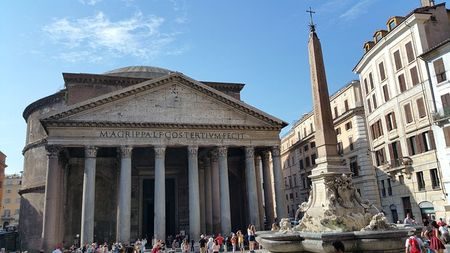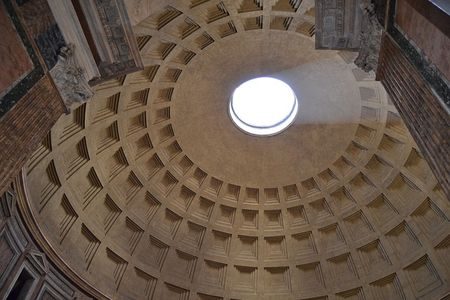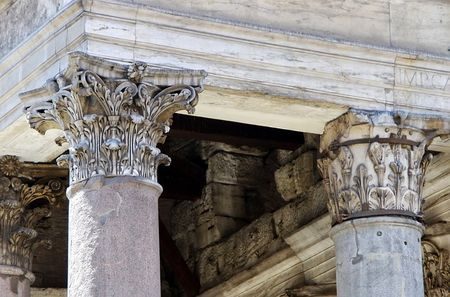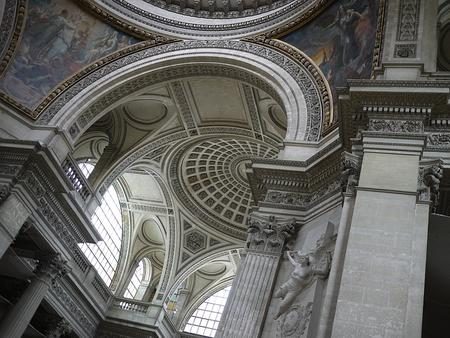The Pantheon of Agrippa also fondly referred to as Roman Pantheon is one of the dazzling architectural highlights of the world. Its origins date back to 27 AD and it’s still exquisitely intact making it the best preserved buildings of the glorious Roman civilization. The Building and its precincts are a powerhouse of history…each era and each emperor has added signature touches to the Pantheon before the papacy took over and made a church out of it.
The Pantheon has huge influence in western architecture and has inspired many lookalikes since the Renaissance times. Some examples of famous constructs inspired by the Pantheon are Santa Maria del Fiore dome in Florence, Belle Isle House in England and even the Thomas Jefferson’s library in Virginia University. The Pantheon literally means “A dedication to all Gods” and it’s still regarded as a symbol of universal reverence to all Godly powers.

History
It all started in 27 AD when the original Agrippa Pantheon was built….a dedication to Romulus the mythical founder of Rome and a heavenly apparition. Many historians agree on the fact that the original builder was Agrippa – the principal aide of Emperor Augustus…the Basilica of Neptune and the Baths of Agrippa were also built to be a part of the same complex. The great fire of 80 AD destroyed the Pantheon completely and Emperor Domitian rebuilt it but again it was struck by deadly lightning in 110 AD.
The Pantheon that you see today was built around 126 AD by Emperor Hadrian in collaboration with a famous Greek architect of those times; Apollodorus of Damascus. For trivia’s sake the same architect was executed by the emperor later when they had a fierce difference of opinion about the temple’s design.
Many floods, earthquakes, pilferages affected the Pantheon but it was always restored back to some version of its originality by one or the other emperor. In the year 609 the Pantheon became the first temple of the Pagans that got converted into a church and that’s how it escaped being destroyed in the middle ages.
History says that the Byzantine king Phocas gave away the building to Pope Boniface IV who tried his best to strip the Pantheon of its Pagan antecedents and build an ode to Christianity there. 28 carts full of holy relics were removed from the Roman catacombs and placed in a porphyry basin right under the high altar. Some members of the Royalty like Emperor Constantius III did great damage to the Pantheon in 663AD when he removed a large portion of the gold and bronze brickwork and looted many other Roman treasures to take it away to Constantinople (now known as Istanbul).
The Pantheon was used as a fortress on several occasions in the middle ages. In the 11th century it was used as a political headquarters by an anti-pope who schemed to overthrow the reigning pope. In Renaissance times it was a quaint custom to climb the walls of the building and look down through the Oculus.
In the 17th century Pope Urban VIII Barberini did the maximum damage to the Pantheon by stripping away 200 tons of bronze that covered the entrance portico. The same bronze was used in fortifying Castel Sant Angelo and creating the iconic baldachin which still exists above the Basilica of Saint Peter.
The Barberini family is still shamed by the locals “Quod non fecerunt barbari fecerunt Barberini” Translated as “What the Barbarians did not do the Barberini did”.
Right now it’s actually a church dedicated to St Mary of Martyrs though the name Pantheon means “Dedication to all Gods”. Mass is celebrated here on Sundays and other sacred days…sometimes high profile weddings are also held here.
The external façade had a massive amount of fine marble and that was stripped away over the centuries….parts of some pilasters are now kept in British museum. There was damage to the sculpture outside the building and its original bronze ceiling but since then most of it has been carefully preserved.
The Romans have always been incredibly proud of the Pantheon and that’s why important burials have taken here. Some of whom who are buried here include Raphael, composer Arcangelo Corelli and Annibale Carracci besides the architect Baldassare Peruzzi. Members of royalty like Queen Margherita of Umberto and Vittorio Emanuele II and Umberto II (both Italian kings) were buried here.
Structure And Notable Areas
Exteriors
The most talked about aspect of the Pantheon is its gigantic Dome with a large hole on top that’s known as the Oculus or the eye of the Pantheon. For 13,000 years the dome was the largest structure of this type and then the United States Capitol Dome was built.
Today it is still the biggest unsupported dome with a diameter of 43.30 meters and the distance between floor to the highest point of the dome is also 43.30 meters; an exercise in symmetry. The entire concrete structure was built without a single steel reinforcing rod…the rotunda stands proudly upright without support.
Though the dome has huge weight the talented Roman engineers used engineering cleverly to reduce its weight as much as possible. Materials used in the upper parts of the Dome are lighter and there is a lot of internal space within the dome walls. The oculus has 7.8 meter diameter and is designed to connect the Gods above and mortals below…it is also the only source of light inside. Rain falls through the oculus but the floor is slanted and drains off the water.

Another celebrated aspect of the Pantheon is its 16 massive Corinthian Columns that weigh 60 tons each and support the Portico. The columns are 11.8 meters high and 1.5 m in diameter. The columns were sourced from Egypt and were floated down the mighty Nile during spring water surges before being transported all across the Mediterranean Sea to the Roman port of Ostia. They were then transferred back into barges and brought into Rome by the Tiber Sea.

The triangle shaped pediment bearing the words “M•AGRIPPA•L•F•COS•TERTIUM•FECIT” are recognizable from afar….meaning it was built by Marcos Agrippa in his 3rd consulate. Incidentally this is the only part of the Pantheon that’s a remnant of the original.
Right in front of the Pantheon is the lovely Fountain of Pantheon. It was designed by the renowned architect Giacomo Della Porta in 1575 and has beautiful marble work created by Leonardo Sormani. The Fontana del Pantheon is a member of an 18 fountain project (In Rome fountains were a source of free and pure drinking water) that was completed in 1575.
The fountain was considerably modified in 1711 by Pope Clement XI who requested that the fountain be changed and the one present now has a stone basin with a Ramses II obelisk and 4 dolphins decorating the base.
The obelisk is sourced from the Temple of Ra in Heliopolis…its twin stands in the Piazza della Minerva (back of Pantheon) and the one in the Pantheon was sourced from Piazza di San Macuto.
Interiors
The interiors of the concrete Cupola is decked up with 5 rows of about 28 coffers that culminate at the eye of the Pantheon/ oculus. When the coffers move upwards they shrink in size and make the ceiling height appear higher than it actually is. Grey shades of plaster cover the cupola interiors now but historians say that original cupola interiors had rich blue colour with glittering bronze accents. Sunlight used to flood the cupola brilliantly while at night the interiors became a stars cape.

Once you walk in through the Portico and the gigantic bronze doors you will walk into the Rotunda. The doors are magnificent but the original ones were even larger and gold plated…the ones you see now are a replacement that have been placed here since 15th century.
Jewel tones (Numidian yellow, purple Phrygian, Yellow Numidian, Granite grey, porphyry red) radiate around the walls, floors and decorative features. The Corinthian fluted columns that line the perimeter of the Rotunda are graceful and create lovely visual appeal. The ground pavement has lovely coloured marble squares and roundels that adds to the grace of the whole structure.
Look around the walls and you will see 7 alcoves that span across the whole perimeter. These spaces have been areas that held sculptures and pagan antiquity works but all have been converted to chapels and tombs. Look through the history section to know which luminaries sleep in their tombs here.
The high alters and the apses inside are also catholic modifications commissioned by Pope Clement XI. There are beautiful paintings of the Virgin and child, Madonna of the Girdle, Annunciation, and Coronation of the Virgin etc. Also look out for the religious sculptures dotting the niches all done by leading sculptors of medieval times. There are many tombs inside but the third niche is known for containing the most famous amongst them…Raphael.
You can locate his tomb by looking out for the inscription ILLE HIC EST RAPHAEL TIMUIT QUO SOSPITE VINCI / RERUM MAGNA PARENS ET MORIENTE MORI (scripted by Cardinal Bembo Raphael’s friend). This basically means here lies Raphael whom nature feared while he was living and and to die with him when he died. Madonna of the Stone…an exquisite painting overlooks the tomb; incidentally the painter is one of Raphael’s pupils Lorenzetto.
Open Hours, Tours & Tickets
The opening times of the Pantheon are 8.30 a.m. to 7.30 p.m. on all regular days…last admission time is 7.15 p.m. On Sundays the Pantheon opens from 9.00 a.m. and closes at 6.00 p.m. ….last admission time is 5.45 p.m. On public holidays the Pantheon opens at 9.00 a.m. and closes at 1.00 p.m. . The Pantheon is closed only on Christmas, New Year and 1st may.
There is no entry fee to enter the Pantheon; incredibly good news as this is one of the key historic buildings in the world. You might have to stand in a queue for about 15 minutes (max) to enter but that’s it. The line moves quickly and entry exit points are well managed.
The Pantheon runs top quality tours for guests who want to enjoy the full history of the place. Comprehensive guides are also available as well as audio tours…you can also use a mobile app to enjoy the Basilica at a leisurely pace.
A guided tour is available at 2 p.m. every Monday to Friday and 3 p.m. on Sunday. The price is around 10 euros for adults and free for kids up to the age 6. Guided tours are available in Italian, Spanish and English…in case you want some other language, using the audio app and the audio guide is a better option.
You can make a phone call or email Pantheon office to inquire about tours and book.
Phone: 347-820-5204 (call between Mondays to Friday 11 a.m. to 4 p.m.). Email [email protected]
The audio guide is a nifty hand held device that explains the history of the Pantheon plus some interesting trivia as you tour the place…the guide works by GPS. You can also use the mobile app (applicable for IOS and android). The app has interactive maps that can be downloaded offline and several listening points with detailed narrations. The app and the guide are available in Italian, English, French, German, Spanish, Russian, Portuguese and Chinese. They are both free to use though obviously you need to return the audio device while exiting the Pantheon.
You can find various options for entry and tours of Pantheon (including combination tours with other attractions) and book online from this Viator site.
The Pantheon is now a church so don’t forget to be appropriately dressed for it. No uncovered knees and shoulders, and modest dressing sense please!!
Best Time To Visit
Anytime and any day is great for viewing the Pantheon. On Sundays lots of historical attractions in Rome have free entry so be prepared for crowds as the nearby Piazzas bustle with architectural wonders. August and late July are avoidable for visiting the Pantheon (remember the Oculus on top of the dome!!)
Also, public restrooms in Rome in general are not very common especially inside and around historical buildings. The Pantheon doesn’t have any public restrooms. The best option is to pop into a café/ gelato shop nearby and use the restroom facilities there but usually you have to buy something for this to happen.
Location
The Pantheon stands in the Piazza della Rotonda in between the Piazza Navona and Fontana di Trevi. The Piazza Rotunda is known for its colorful street artists, quaint cafes and gelato shops.
The nearest subway/ metro stop is the Barberini Line a (Orange). The Pantheon is about an 8 minute walk from there. If you are on a hop on hop off bus then get off at the Trevi Fountain stop and then take a 5 minute walk.
One amazing attraction near the Pantheon stands at the junction of via Florida and via Arenula a short stroll away from Piazza Navona. The Torre Argentina Cat Sanctuary has an incredible feline population. Locals say that Julius Caesar was stabbed to death at this very spot…the sanctuary is open from noon to 8 p.m. everyday.
It’s a very good idea to combine a visit to the Trevi fountain, Piazza di Sant’ignazio, Piazza Venezia and Piazza della Rotonda with your tour of the Pantheon. Visiting all these places will take up a day fruitfully. The Piazza della Rotonda is right outside the Pantheon. You can also explore the Campo di Fiori area and the Doria Pamphilj and the lovely churches around Piazza Navona. It will take you half an hour to reach the Vatican City from the Pantheon by foot but it’s better to set aside a day especially for the Vatican Museums.
As you exit the Pantheon take a left turn to get into lane Via della Rotonda and walk into the gelato shop called Cremeria Monteforte. This stands at the exact spot of a café that Audrey Hepburn used to frequent when she shot for ‘Roman Holiday’ (the movie used the Pantheon location extensively).
Piazza della Rotonda, 00186 Rome, Pigna, Italy
Phone: +39 347 8205204; Official Website
 A travel addict. Still celebrating the day when he quit his high-profile corporate job to pursue his passion for travel writing.
A travel addict. Still celebrating the day when he quit his high-profile corporate job to pursue his passion for travel writing.